The Sedimentary Record of Marine–Continental Transitional Shales in the Upper Triassic of Xujiahe Formation, Southeast Sichuan Basin, China
Abstract
1. Introduction
2. Geologic Setting
3. Materials and Methods
3.1. Field Profile Observation
3.2. Sporopollen Analysis
3.3. Major and Trace Elements Determination
3.4. Total Organic Carbon Analysis
3.5. Kerogen Maceral Determination
4. Results
4.1. Sedimentological Characteristics
4.2. Fossils and Sporopollen Fossil Analysis
4.3. Element Geochemistry
4.3.1. Major Elements
4.3.2. Trace Element Geochemistry
4.4. Type of Organic Matter
5. Discussion
5.1. Evidence of Marine–Continental Transitional Shales
5.1.1. Indicator of Sedimentary Structure
5.1.2. Indicator of Biological Evolution
5.1.3. Major and Trace Element Geochemistry
5.1.4. Indicator of Organic Matter Type
5.2. Sedimentary Model and Hydrocarbon Potential
6. Conclusions
Author Contributions
Funding
Data Availability Statement
Acknowledgments
Conflicts of Interest
Abbreviations
| Fm | Formation |
| Mbr | Member |
| SubMbr | Submember |
| TOC | Total organic carbon |
References
- Ma, Y.S.; Cai, X.Y.; Zhao, P.R. China’s shale gas exploration and development: Understanding and practice. Pet. Explor. Dev. 2018, 45, 589–603. [Google Scholar]
- Luo, Q.Y.; Xiao, Z.H.; Dong, C.Y.; Ye, X.Z.; Li, H.J.; Zhang, Y.; Ma, Y.; Ma, L.; Xu, Y.H. The geochemical characteristics and gas potential of the Longtan formation in the eastern Sichuan Basin, China. J. Pet. Sci. Eng. 2019, 179, 1102–1113. [Google Scholar]
- Wang, F.T.; Guo, S.B. Shale gas content evolution in the Ordos Basin. Int. J. Coal Geol. 2019, 211, 103231. [Google Scholar]
- Nie, H.K.; Chen, Q.; Li, P.; Dang, W.; Zhang, J.C. Shale gas potential of Ordovician marine Pingliang shale and Carboniferous–Permian transitional Taiyuan–Shanxi shales in the Ordos Basin, China. Aust. J. Earth Sci. 2023, 70, 411–422. [Google Scholar]
- Zhou, G.X.; Wei, G.Q.; Hu, G.Y. The geochemical and organic petrological characteristics of coal measures of the Xujiahe formation in the Sichuan Basin, China. Energy Explor. Exploit. 2019, 37, 889–906. [Google Scholar]
- Deng, T.; Li, Y.; Wang, Z.J.; Yu, Q.; Dong, S.L.; Yan, L.; Hu, W.C.; Chen, B. Geochemical characteristics and organic matter enrichment mechanism of black shale in the Upper Triassic Xujiahe Formation in the Sichuan basin: Implications for paleoweathering, provenance and tectonic setting. Mar. Pet. Geol. 2019, 109, 698–716. [Google Scholar]
- Dai, J.X.; Ni, Y.Y.; Zou, C.N.; Tao, S.Z.; Hu, G.Y.; Hu, A.P.; Yang, C.; Tao, X.W. Carbon isotope features of alkane gases in the coal measures of the Xujiahe Formation in the Sichuan Basin and their significance to gas–source correlation. Oil Gas Geol. 2009, 30, 519–529, (In Chinese with English Abstract). [Google Scholar]
- Luo, L.; Jia, D.; Qi, J.F.; Wei, G.Q.; Deng, F. Tectono–sedimentary Evolution of the Late Triassic Xujiahe Formation in the Sichuan Basin. Acta Geol. Sin.-Engl. Ed. 2013, 87, 1554–1568. [Google Scholar]
- Tan, X.C.; Xia, Q.S.; Chen, J.S.; Li, L.; Liu, H.; Luo, B.; Xia, J.W.; Yang, J.J. Basin–Scale Sand Deposition in the Upper Triassic Xujiahe Formation of the Sichuan Basin, Southwest China: Sedimentary Framework and Conceptual Model. J. Earth Sci. 2013, 24, 89–103. [Google Scholar]
- Xu, C.M.; Gehenn, J.M.; Zhao, D.H.; Xie, G.Y.; Teng, M.K. The fluvial and lacustrine sedimentary systems and stratigraphic correlation in the Upper Triassic Xujiahe Formation in Sichuan Basin, China. AAPG Bull. 2015, 99, 2023–2041. [Google Scholar]
- Lai, J.; Wang, G.W.; Fan, Z.Y.; Chen, J.; Wang, S.C.; Fan, X.Q. Sedimentary characterization of a braided delta using well logs: The Upper Triassic Xujiahe Formation in Central Sichuan Basin, China. J. Pet. Sci. Eng. 2017, 154, 172–193. [Google Scholar]
- Gou, M.X.; Lu, G.; Deng, B.; Wang, C.C.; Li, Z.W.; Yu, Y.; Yang, R.J.; Jin, X. Tectonic–paleogeographic evolution of the Late Triassic in the Sichuan basin, SW China: Constraints from sedimentary facies and provenance analysis of the Xujiahe Formation. Mar. Pet. Geol. 2024, 160, 106649. [Google Scholar]
- Peng, Y.; Zheng, M.P.; Zhang, Y.S.; Xing, E.Y.; Gui, B.L.; Zuo, F.F. Geochronology and geochemistry of lithium–rich tuffs in the Sichuan basin, western Yangtze: Implication for the magmatic origin and final closure of eastern Paleo–Tethys. Geosci. Fronti. 2023, 14, 101480. [Google Scholar]
- Liu, X.W.; Jiang, F.J.; Zheng, X.W.; Gao, Y.; Zhou, S.Y. Sedimentary Record of the Bio–Geological Events in Tethys: Insight from the Permian Yangtze Block Breakup in the Sichuan Basin. Appl. Sci. 2024, 14, 11863. [Google Scholar] [CrossRef]
- Jian, X.; Weislogel, A.; Pullen, A. Triassic Sedimentary Filling and Closure of the Eastern Paleo–Tethys Ocean: New Insights from Detrital Zircon Geochronology of Songpan–Ganzi, Yidun, and West Qinling Flysch in Eastern Tibet. Tectonics 2019, 38, 767–787. [Google Scholar]
- Meng, L.F.; Chen, W.; Shen, T.; Cai, J.F. A Study on the Provenance of Early to Late Triassic Clastic Rocks From the Northwestern Sichuan Basin, Southwestern China: Constraints on the Early Mesozoic Tectonic Evolution of the Western Yangtze Block. Fronti. Earth Sci. 2022, 10, 940301. [Google Scholar]
- Li, Y.Q.; Li, S.J.; He, D.F.; Gao, J.; Wang, Y.C.; Huang, H.Y.; Zhang, J.T.; Zhang, Y. Middle Triassic tectono–sedimentary development of Sichuan Basin: Insights into the cratonic differentiation. Geol. J. 2020, 56, 1858–1878. [Google Scholar]
- Tang, J.; Wang, J.; Wu, G.H.; Wen, Y.Y.; Nance, R.D.; He, B.; Li, C.H.; Zou, Y. Retreating subduction–related intracratonic rifting in the Ediacaran Sichuan Basin (SW China). Precambrian Res. 2024, 413, 107569. [Google Scholar]
- Yan, Z.K.; Tian, Y.T.; Li, R.; Vermeesch, P.; Sun, X.L.; Li, Y.; Rittner, M.; Carter, A.; Shao, C.J.; Huang, H.; et al. Late Triassic tectonic inversion in the upper Yangtze Block: Insights from detrital zircon U–Pb geochronology from south–western Sichuan Basin. Basin Res. 2019, 31, 92–113. [Google Scholar]
- Li, Z.Q.; Ying, D.L.; Li, H.K.; Yang, G.; Zeng, Q.; Guo, X.Y.; Chen, X. Evolution of the western Sichuan basin and its superimposed characteristics, China. Acta Petrol. Sin. 2011, 27, 2362–2370. [Google Scholar]
- Bo, S.S.; Tian, J.X.; Wang, Y.T.; Fu, S.; Chen, H.C.; Sun, G.Q. Sedimentary environment evolution of marine–continental transitional facies in Xujiahe Formation, northeastern Sichuan Basin: Evidence from element geochemistry. NGGS 2024, 35, 645–660, (In Chinese with English Abstract). [Google Scholar]
- Blakey, R. ~200 Ma Base Map. Colorado Plateau Geosystem Inc. Available online: http://deeptimemaps.com/ (accessed on 6 October 2022).
- Lu, T.H.; Zhang, X.; Zhang, T.S.; Cheng, Q.S.; He, F.Y.; Zeng, J.L.; Popa, M.E.; Huang, H.; Li, S.X.; Ma, Z.H.; et al. The influence of the Luzhou paleo–uplift in the southeast of the Sichuan Basin on the development of the Upper Triassic Xujiahe Formation. J. Stratigr. 2023, 47, 176–190, (In Chinese with English Abstract). [Google Scholar]
- Mei, M.X.; Liu, S.F. The Late Triassic Sequence–Stratigraphic Framework of the Upper Yangtze Region, South China. Acta Geol. Sin. Engl. Ed. 2017, 91, 51–75. [Google Scholar]
- Li, Y.J.; Shao, L.Y.; Eriksson, K.A.; Tong, X.; Gao, C.X.; Chen, Z.S. Linked sequence stratigraphy and tectonics in the Sichuan continental foreland basin, Upper Triassic Xujiahe Formation, southwest China. J. Asian Earth Sci. 2014, 88, 116–136. [Google Scholar]
- Liu, S.G.; Yang, Y.; Deng, B.; Zhong, Y.; Wen, L.; Sun, W.; Li, Z.W.; Jansa, L.; Li, J.X.; Song, J.M.; et al. Tectonic evolution of the Sichuan Basin, Southwest China. Earth-Sci. Rev. 2021, 213, 103470. [Google Scholar]
- Shu, H.L.; He, F.Y.; Li, J.L.; Zhang, J.H.; Li, M.L.; Rui, Y.; Zou, C.; Yao, Q.C.; Mei, J.; Li, Y.J. Geological characteristics and favorable exploration areas of Wufeng Formation–Longmaxi Formation deep shale in the Da’an Block, Sichuan Basin. Nat. Gas Ind. 2023, 43, 30–43, (In Chinese with English Abstract). [Google Scholar]
- Xu, M.L.; Yang, Y.B.; Sun, C.Y.; Qiu, G.E.; Chen, L.; Jing, L. Geophysical Characterisation and Oil–Gas Resource Analysis of the Southern Huaying Mountain Fault Zone, Sichuan Basin, China. Minerals 2023, 13, 270. [Google Scholar] [CrossRef]
- Tang, L.J.; Yang, K.M.; Jin, W.Z.; Wan, G.M.; Lü, Z.Z.; Yu, Y.X. Differential Tectonic Deformation of the Longmen Mountain Thrust Belt, Western Sichuan Basin, China. Acta Geol. Sin.-Engl. Ed. 2009, 83, 158–169. [Google Scholar]
- Zhang, Y.; Jia, D.; Shen, L.; Yin, H.W.; Chen, Z.X.; Li, H.B.; Li, Z.G.; Sun, C. Provenance of detrital zircons in the Late Triassic Sichuan foreland basin: Constraints on the evolution of the Qinling Orogen and Longmen Shan thrust–fold belt in central China. Int. Geol. Rev. 2015, 57, 1806–1824. [Google Scholar]
- Mu, H.X.; Yan, D.P.; Qiu, L.; Yang, W.X.; Kong, R.Y.; Gong, L.X.; Li, S.B. Formation of the Late Triassic western Sichuan foreland basin of the Qinling Orogenic Belt, SW China: Sedimentary and geochronological constraints from the Xujiahe Formation. J. Asian Earth Sci. 2019, 183, 103938. [Google Scholar]
- Chen, H.L.; Zhu, M.; Chen, S.Q.; Xiao, A.C.; Jia, D.; Yang, G. Basin–orogen patterns and the late Triassic foreland basin conversion process in the western Yangtze Block, China. J. Asian Earth Sci. 2020, 194, 104311. [Google Scholar]
- Wang, Z.H.; Hao, C.G.; Jin, H.; Cun, J.F.; Wu, X.Q.; Bo, D.M.; Su, Y.Q. Geochemical characteristics and hydrocarbon generation potential of main source rocks in the Upper Triassic Xujiahe Formation, Sichuan Basin, China. Fronti. Earth Sci. 2023, 11, 1233959. [Google Scholar]
- Zhang, M.; Huang, G.H.; Li, H.B.; Hu, G.Y.; Zhang, S.C. Molecular geochemical characteristics of gas source rocks from the Upper Triassic Xujiahe Formation indicate transgression events in the Sichuan Basin. Sci. China-Earth Sci. 2012, 55, 1260–1268. [Google Scholar]
- Zhang, X.; Zhao, X.M.; Ge, J.W.; Li, S.X.; Zhang, T.S. Karst topography paces the deposition of lower Permian, organic–rich, marine–continental transitional shales in the southeastern Ordos Basin, northwestern China. AAPG Bull. 2024, 108, 849–875. [Google Scholar]
- SY/T 5915–2018; Analysis and Identification for Fossil Spore and Pollen. Petroleum Industry Press: Beijing, China, 2018.
- DZ/T 0279.2-2016; Analysis Methods for Regional Geochemical Sample-Part 2: Determination of Calcium Oxide etc. 27 Elements Content by Inductively Coupled Plasma Optical Emission Spectrometry. Standards Press of China: Beijing, China, 2016.
- GB/T3286 (1–9)–2014; Methods for Chemical Analysis of Limestone and Dolomite—Part 1–9: The Determination of Iron Oxide Content—The o-Phenanthroline Spectrophotometric Method and the Flame Atomic Absorption Spectrometric Method. Standards Press of China: Beijing, China, 2014.
- GB/T 14506.28–2010; Methods for Chemical Analysis of Silicate Rocks—Part 28: Determination of 16 Major and Minor Elements Content. Standards Press of China: Beijing, China, 2010.
- DZ/T 0279.3–2016; Analysis Methods for Regional Geochemical Sample-Part 3: Determination of Barium, Beryllium, Bismuth etc. 15 Elements Content by Inductively Coupled Plasma Mass Spectrometry. Standards Press of China: Beijing, China, 2016.
- DZ/T 0279.32–2016; Analysis Methods for Regional Geochemical Sample-Part 32: Determination of Lanthanum, Cerium etc. 15 Earth Elements Content by Pressurized Acid Digestion-Inductively Coupled Plasma Mass Spectrometry. Standards Press of China: Beijing, China, 2016.
- GB/T 19145–2003; Determination of Total Organic Carbon in Sedimentary Rock. Standards Press of China: Beijing, China, 2003.
- SY/T 5125-2014; Method of Identification Microscopically the Macerals of Kerogen and Indivision the Kerogen Type by Transmitted-Light and Fluorescence. Petroleum Industry Press: Beijing, China, 2014.
- Shang, Y.K.; Li, Y.M. Sporopollen assemblage of the Upper Triassic in the Mosuo River Valley, Baoding, Sichuan Province. Acta Palaeontol. Sin. 1991, 30, 334–353, 358–359, 423–426, (In Chinese with English Abstract). [Google Scholar]
- Lei, Z.Q. The Sporo–Pollen Assemblage of the Shezhe Formation of Yipinglang Coal Series in Luquan of Yunnan, and Its Stratigraphical Significance. J. Integr. Plant Biol. 1978, 20, 229—236, 291—292, (In Chinese with English Abstract). [Google Scholar]
- Shang, Y.K. Geographical Division of the Late Triassic Pollen Flora in China. Acta Palaeontol. Sin. 1998, 37, 37–53, (In Chinese with English Abstract). [Google Scholar]
- Morbey, J.S. The palynostratigraphy of the Rhaetian stage, Upper Triassic in the Kendelbachgraben, Austria. Palaeontographica. 1975, B152, 1–75. [Google Scholar]
- Pauli, H.; Gottfried, M.; Dullinger, S.; Abdaladze, O.; Akhalkatsi, M.; Alonso, J.L.B.; Coldea, G.; Dick, J.; Erschbamer, B.; Calzado, R.F.; et al. Recent plant diversity changes on Europe’s Mountain summits. Science 2012, 336, 353–355. [Google Scholar]
- Pieńkowski, G.; Niedźwiedzki, G.; Waksmundzka, M. Sedimentological, palynological and geochemical studies of the terrestrial Triassic–Jurassic boundary in northwestern Poland. Geol. Mag. 2012, 149, 308–332. [Google Scholar]
- Wang, Z.W.; Wang, J.; Yu, F.; Fu, X.G.; Chen, W.B.; Zhan, W.Z.; Song, C.Y. Geochemical characteristics of the Upper Triassic black mudstones in the eastern Qiangtang Basin, Tibet: Implications for petroleum potential and depositional environment. J. Pet. Sci. Eng. 2021, 207, 109180. [Google Scholar]
- Zhao, L.Y.; Zhou, P.M.; Lou, Y.; Zhao, Y.Z.; Liu, W.; Liao, Z.W.; Xia, P. Geochemical Characteristics and Sedimentary Environment of the Upper Permian Longtan Coal Series Shale in Western Guizhou Province, South China. Geofluids 2021, 2021, 9755861. [Google Scholar]
- Hakimi, M.H.; Alaug, A.S.; Al Faifi, H.J.; Alramisy, G.A.; Lashin, A.A. Late Jurassic Safer Salt Member in the Al–Jawf sub–basin of NW Sabatayn Basin, Yemen: Geochemical evaluation of organic–rich oil–source rock potential. Pet. Sci. Technol. 2019, 37, 645–654. [Google Scholar]
- Craddock, P.R.; Haecker, A.; Bake, K.D.; Pomerantz, A.E. Universal Curves Describing the Chemical and Physical Evolution of Type II Kerogen during Thermal Maturation. Energy Fuels 2020, 34, 15217–15233. [Google Scholar]
- Du, Y.; Wang, X.Z.; Zhao, R.R.; Chen, C.; Wen, S.Y.; Tang, R.F.; Mo, Q.W.; Zhang, J.Z.; Zhang, Y.; He, S. Controlling factors of organic matter enrichment in continental shale: A case study of the Jurassic Da’anzhai member in the Sichuan Basin. Fronti. Earth Sci. 2022, 10, 921529. [Google Scholar]
- Lou, T.Y.; Feng, C.J.; Sun, M.S.; Chen, Z.Q. The Upper Triassic Braided River Thin–Bedded Tight Sandstone in the Yanchang Formation, Ordos Basin: Sedimentary Characteristics, Seismic Forecasting Method, and Implication. Processes 2023, 11, 1303. [Google Scholar] [CrossRef]
- Ghinassi, M.; Nemec, W.; Aldinucci, M.; Nehyba, S.; Özaksoy, V.; Fidolini, F. Plan–form evolution of ancient meandering rivers reconstructed from longitudinal outcrop sections. Sedimentology 2014, 61, 952–977. [Google Scholar]
- Zhang, L.; Bao, Z.D.; Dou, L.X.; Zang, D.S.; Mao, S.W.; Song, J.; Zhao, J.H.; Wang, Z.C. Sedimentary characteristics and pattern of distributary channels in shallow water deltaic red bed succession: A case from the Late Cretaceous Yaojia formation, southern Songliao Basin, NE China. J. Pet. Sci. Eng. 2018, 171, 1171–1190. [Google Scholar]
- Zeng, Q.L.; Zhang, X.L.; Zhang, R.H.; Zhao, J.L.; Hou, G.F.; Ji, Y.G. Characteristics of tidal action sedimentary system and distribution of favorable sand bodies of Silurian in Tazhong area, Tarim basin, NW China. Quat. Int. 2018, 468A, 62–71. [Google Scholar]
- Zhang, X.L.; Fan, D.J.; Xu, J.P.; Liu, M.; Tian, Y.; Chen, B.; Sun, Z.L.; Liu, W.L.; Yang, Z.S. Sedimentary laminae in muddy inner continental shelf sediments of the East China Sea: Formation and implications for geochronology. Quat. Int. 2018, 464, 343–351. [Google Scholar]
- Flaig, P.P.; Hasiotis, S.T.; Prather, T.J.; Burton, D. Characteristics of a campanian delta deposit controlled by alternating river floods and tides: The loyd sandstone, rangely anticline, Colorado, USA. J. Sediment. Res. 2019, 89, 1181–1206. [Google Scholar]
- Ahmad, W.; Gingras, M.K.; Ranger, M.J.; MacEachern, J.A.; Zonneveld, J.P. Depositional setting and trace fossil suites of the early Cambrian (series 2, stage 4) Khussak Formation, east–central salt range, north–west sub–Himalayas, Pakistan. Mar. Pet. Geol. 2024, 165, 106858. [Google Scholar]
- Schwartz, T.M.; Graham, S.A. Stratigraphic architecture of a tide–influenced shelf–edge delta, Upper Cretaceous Dorotea Formation, Magallanes–Austral Basin, Patagonia. Sedimentology. 2015, 62, 1039–1077. [Google Scholar]
- Kumar, P.; Devi, K.L.; Chakraborty, P.P.; Rajkumar, H.S. Depositional architecture of sub–aqueous part of a tide–dominated delta and its palaeogeographic implications: Laisong Formation (Barail Group), Indo–Myanmar Ranges, western Manipur. J. Earth Syst. Sci. 2022, 131, 103. [Google Scholar]
- Dashtgard, S.E.; Gingras, M.K.; MacEachern, J.A. Tidally modulated shorefaces. J. Sediment. Res. 2009, 79, 793–807. [Google Scholar]
- Gong, Z.J.; Li, Q.W.; Luo, M.; Dai, C.C.; Peng, H.M. Sedimentary facies and chronological study for a Late Pleistocene sand layer with swash cross bedding within a sand hill at north of Poyang Lake, as inferred from sedimentary structure and optical dating of K–feldspar and quartz grains. Quat. Int. 2023, 673, 29–39. [Google Scholar]
- Hovikoski, J.; Uchman, A.; Weibel, R.; Nohr–Hansen, H.; Sheldon, E.; Ineson, J.; Bjerager, M.; Therkelsen, J.; Olivarius, M.; Larsen, M.; et al. Upper Cretaceous bottom current deposits, north–east Greenland. Sedimentology 2020, 67, 3619–3654. [Google Scholar]
- Huang, Y.T.; Tan, X.F.; Liu, E.T.; Wang, J.; Wang, J.P. Sedimentary processes of shallow–marine turbidite fans: An example from the Huangliu Formation in the Yinggehai Basin, South China Sea. Mar. Pet. Geol. 2021, 132, 105191. [Google Scholar]
- Blanchard, S.; Matheson, E.J.; Fielding, C.R.; Best, J.L.; Bryk, A.B.; Howell, K.J.; Monson, C.C.; Mahoney, G.; Peakall, J. Early burial mud diapirism and its impact on stratigraphic architecture in the Carboniferous of the Shannon Basin, County Clare, Ireland. Sedimentology 2019, 66, 329–361. [Google Scholar]
- Liu, Z.S.; Li, L.Q.; Wang, Y.D. Sporopollen assemblage of the Late Triassic in Xuanhan, Sichuan Province and its paleovegetation and paleoclimate significance. Acta Micropalaeontol. Sin. 2015, 32, 43–62, (In Chinese with English Abstract). [Google Scholar]
- Zheng, R.C.; Li, G.H.; Chang, H.L.; Li, S.L.; Wang, X.J.; Wang, C.Y. Sedimentary sequence and paleogeographic characteristics of the Upper Triassic Xujiahe Formation in eastern Sichuan basin. Geol. China 2015, 42, 1024–1036, (In Chinese with English Abstract). [Google Scholar]
- Pole, M.; Wang, Y.D.; Dong, C.; Xie, X.P.; Tian, N.; Li, L.Q.; Zhou, N.; Lu, N.; Xie, A.W.; Zhang, X.Q. Fires and storms–a Triassic–Jurassic transition section in the Sichuan Basin, China. Palaeobiodivers. Palaeoenviron. 2018, 98, 29–47. [Google Scholar] [CrossRef]
- Li, L.Q.; Wang, Y.D. Late Triassic palynofloras in the Sichuan Basin, South China: Synthesis and perspective. Palaeoworld 2016, 25, 212–238. [Google Scholar] [CrossRef]
- Li, L.Q.; Wang, Y.D.; Vajda, V.; Liu, Z.S. Late Triassic ecosystem variations inferred by palynological records from Hechuan, southern Sichuan Basin, China. Geol. Mag. 2018, 155, 1793–1810. [Google Scholar]
- Lu, N.; Wang, Y.D.; Popa, M.E.; Xie, X.P.; Li, L.Q.; Xi, S.N.; Xin, C.L.; Deng, C.T. Sedimentological and paleoecological aspects of the Norian-Rhaetian transition (Late Triassic) in the Xuanhan area of the Sichuan Basin, Southwest China. Palaeoworld 2019, 28, 334–345. [Google Scholar] [CrossRef]
- Chen, H.D.; Li, J.; Zhang, C.G.; Cheng, L.X.; Cheng, L.J. Discussion of sedimentary environment and its geological enlightenment of Shanxi Formation in Ordos Basin. Acta. Petrol. Sin. 2011, 27, 2213–2229. [Google Scholar]
- Dashtgard, S.E.; Wang, A.H.; Pospelova, V.; Wang, P.L.; La Croix, A.; Ayranci, K. Salinity indicators in sediment through the fluvial–to–marine transition (Fraser River, Canada). Sci. Rep. 2022, 12, 14303. [Google Scholar]
- Lei, B.J.; Que, H.P.; Hu, N.; Niu, Z.J.; Wang, H. Geochemistry and sedimentary environments of the Palaeozoic siliceous rocks in western Hubei. Sediment. Geol. Tethyan Geol. 2002, 22, 70–79, (In Chinese with English Abstract). [Google Scholar]
- Shi, Z.S.; Zhou, T.Q.; Guo, C.M. Clastic sedimentary records of the Upper Triassic Sichuan Basin, China: Implications for the transition from marine to transitional environment. Geol. J. 2022, 57, 4393–4411. [Google Scholar] [CrossRef]
- Jones, B.; Manning, D.A.C. Comparison of geochemical indices used for the interpretation of palaeoredox conditions in ancient mudstones. Chem. Geol. 1994, 111, 111–129. [Google Scholar] [CrossRef]
- Nie, Y.; Fu, X.G.; Xu, W.L.; Wen, H.G.; Wang, Z.W.; Song, C.Y. Redox conditions and climate control on organic matter accumulation and depletion during the Toarcian in the Qiangtang Basin, eastern Tethys. Int. J. Earth. Sci. (Geol. Rundsch.) 2020, 109, 1977–1990. [Google Scholar]
- Gu, J.L.; Zheng, R.C.; Luo, P.; Yang, Z.X. Sequence stratigraphic framework and source–reservoir–cap rock of Xujiahe Formation in West Sichuan depression. J. CDUT-Sci. Technol. Ed. 2004, 31, 282–290, (In Chinese with English Abstract). [Google Scholar]
- Lin, L.B.; Chen, H.D.; Jiang, P.; Hu, X.-Q. Sedimentary Facies and Lithofacies Paleogeographic Evolution of the Xujiahe Formation in the Western Sichuan Foreland Basin. J. Chengdu Univ. Technol. (Sci. Technol. Ed.) 2006, 33, 376–383, (In Chinese with English Abstract). [Google Scholar]
- Wang, L.J.; Zhang, G.C.; Li, C.Q. Reservoir Characteristic of Triassic Jia’ er1–Jiayi Gas Pool of Baoyuan Structure, Chishui, Guizhou. Guizhou Geol. 2004, 79, 94–98, (In Chinese with English Abstract). [Google Scholar]
- Zhang, Z.; Zeng, W.; Yang, X.Y. The Division and Distribution of Diagenetic Facies of Xujiuhe Formation in Upper Triassic, Southern Sichuan. J. SWPU-Sci. Technol. Ed. 2006, 28, 13–15+23+112, (In Chinese with English Abstract). [Google Scholar]
- Jiang, Z.X.; Tian, J.J.; Chen, G.J.; Li, X.Z.; Zhang, M.L. Sedimentary characteristics of the Upper Triassic in western Sichuan foreland basin. J. Palaeogeogr. 2007, 9, 143–154, (In Chinese with English Abstract). [Google Scholar]
- Gao, Z.Y.; Han, G.M.; Zhang, L.H. Parasequence of fluvial deposit:a case study of the Xujiahe Formation in Central Sichuan. Oil Gas Geol. 2007, 28, 59–68, (In Chinese with English Abstract). [Google Scholar]
- Liu, J.H.; Zhang, S.Q.; Sun, Y.T.; Wei, C.G. Correlation and Evolution of the Upper Triassic Xujiahe Formation in the West Sichuan Foreland Basin. J. Stratigr. 2007, 31, 190–196, (In Chinese with English Abstract). [Google Scholar]
- Hou, F.H.; Jiang, Y.Q.; Fang, S.X.; Guo, G.A.; Yang, J.L. Sedimentary model of sandstone in second and fourth members of Xiangxi Formation in the Upper Triassic of Sichuan Basin. Acta Pet. Sin. 2005, 26, 30–37, (In Chinese with English Abstract). [Google Scholar]
- Zhao, X.F.; Lu, Z.G.; Zhang, W.L.; Peng, H.R.; Kang, R.D. Paralic tidal deposits in the Upper Triassic Xujiahe Formation in Anyue area, the Sichuan Basin. Nat. Gas Ind. 2008, 28, 14–18+134, (In Chinese with English Abstract). [Google Scholar]
- Lai, W.; Ruan, Z.; Wang, L.D.; Shen, Z.H. Geochemical Characteristics and Geological Significance of Mudstones from the Xujiahe Formation in the Qilixia Section, Northeastern Sichuan Basin. Acta Petrol. Mineral. 2019, 38, 657–672, (In Chinese with English Abstract). [Google Scholar]
- Wu, Y.P.; Liu, C.L.; Jiang, F.J.; Hu, T.; Zhang, C.X.; Lv, J.H.; Hu, M.L.; Huang, R.D.; Wu, G.Y.; Awan, R.S. Hydrocarbon generation and expulsion of the Fengcheng Formation in the Mahu sag, Junggar Basin, China: Implications for shale oil resource potential. Interpret.-J. Sub. 2023, 11, T145–T159. [Google Scholar]
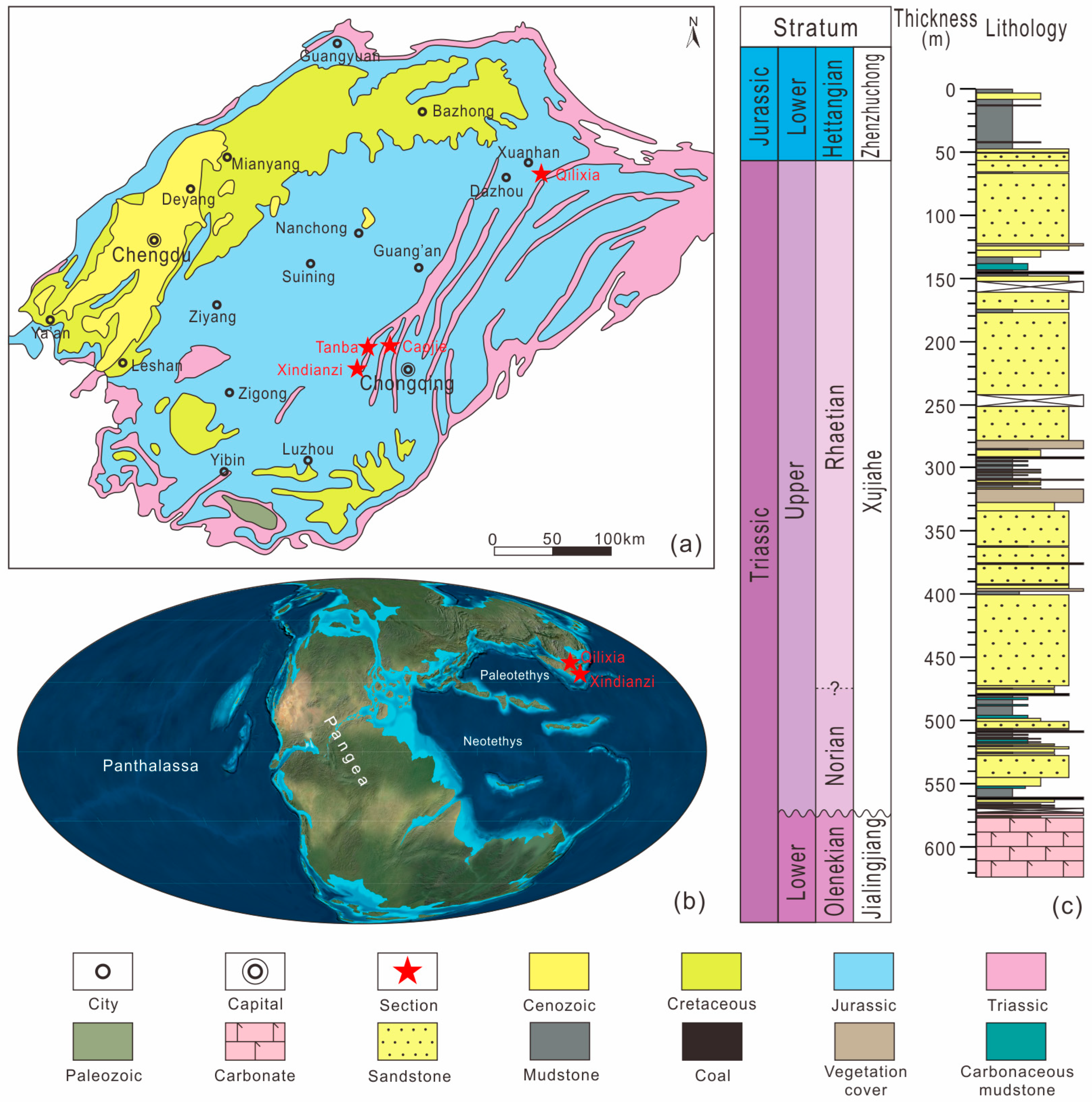
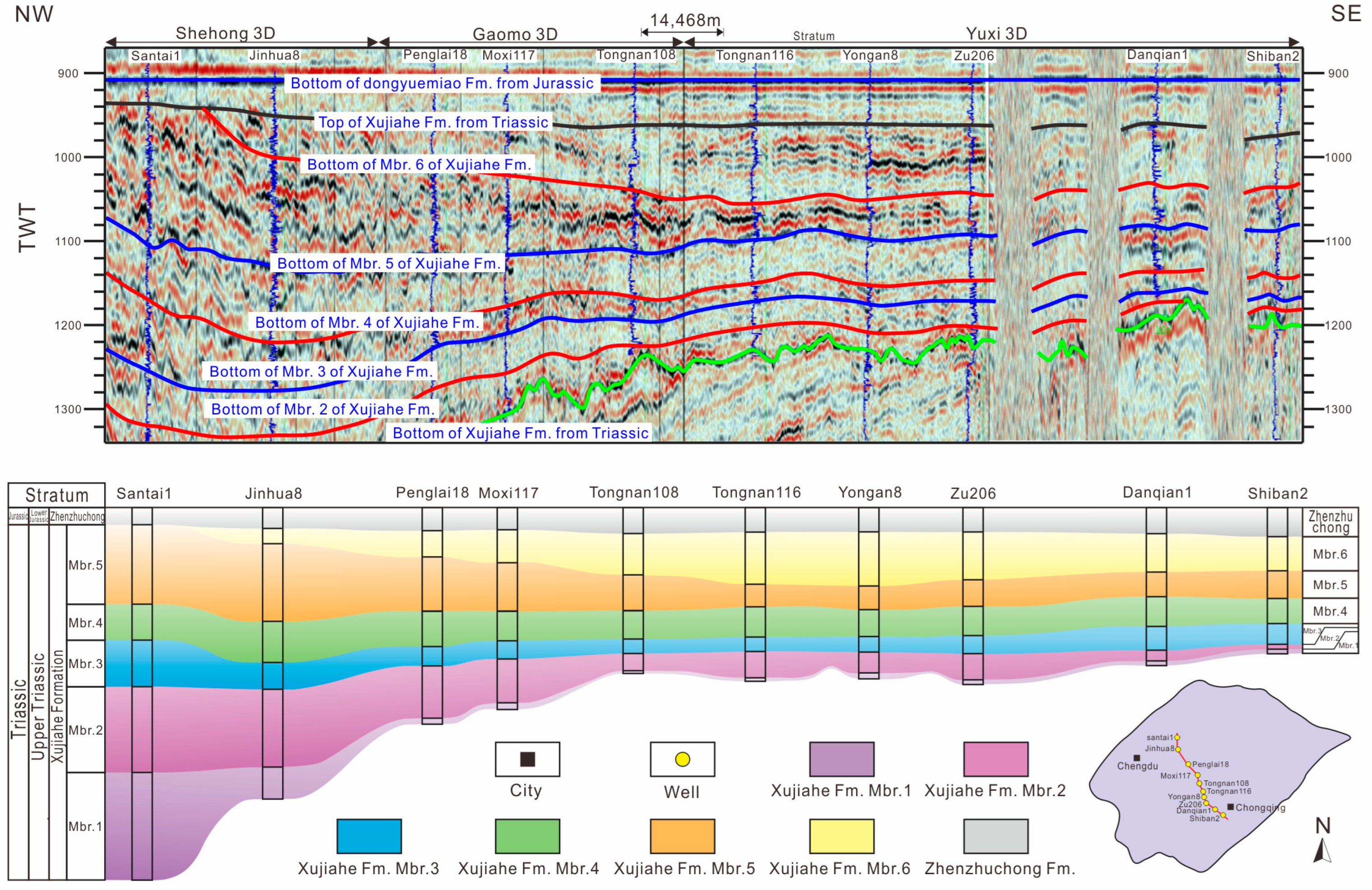
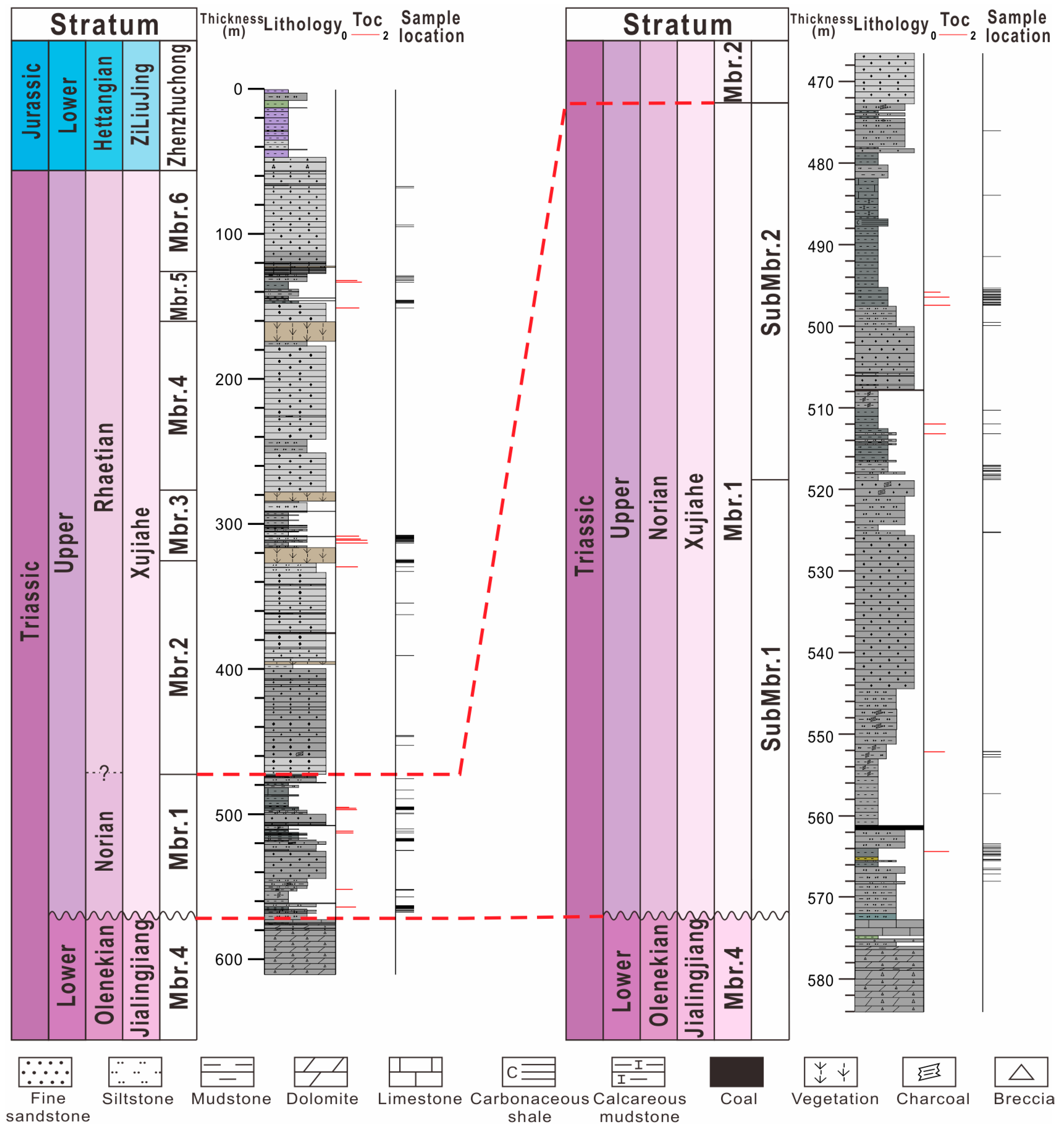
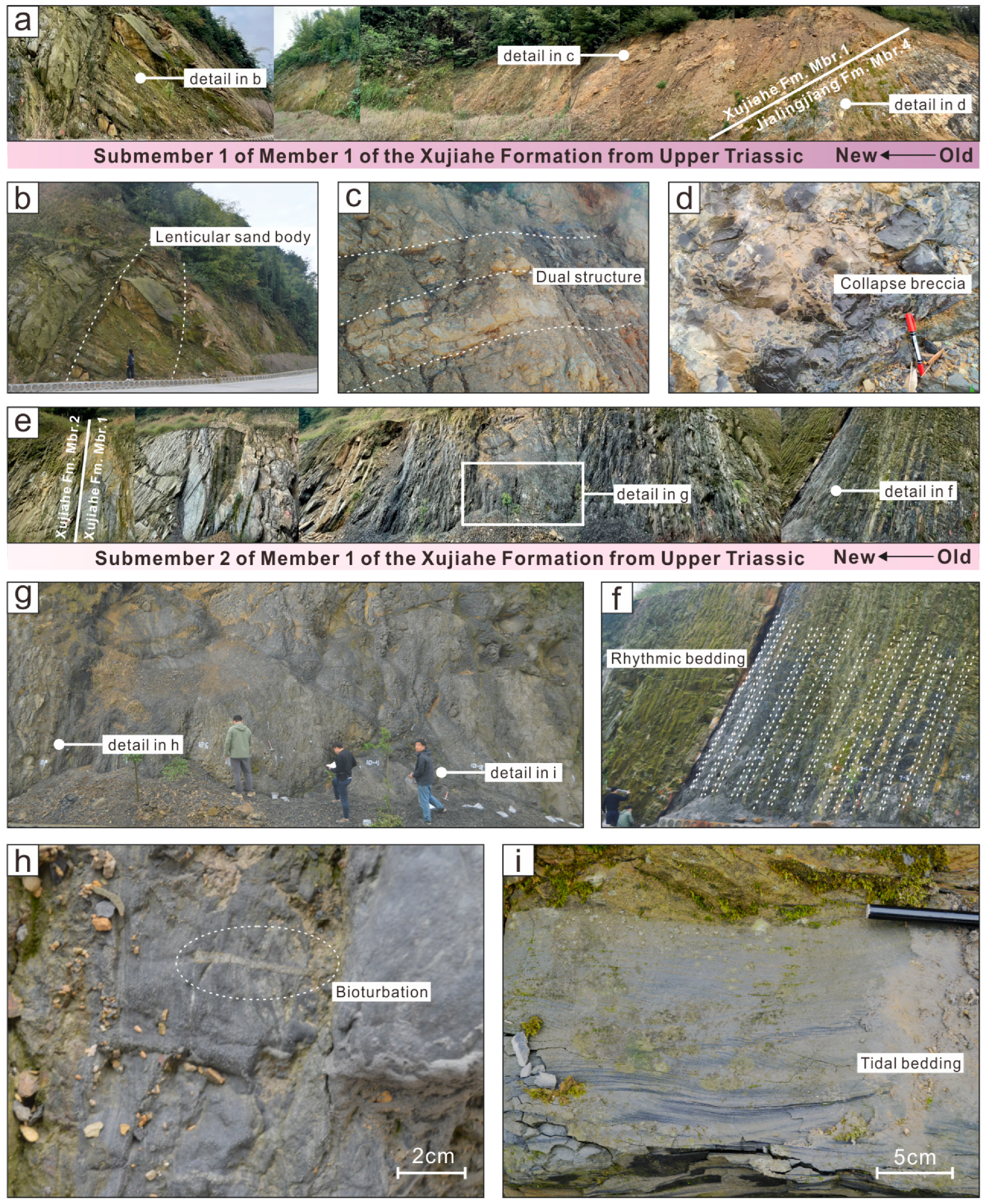
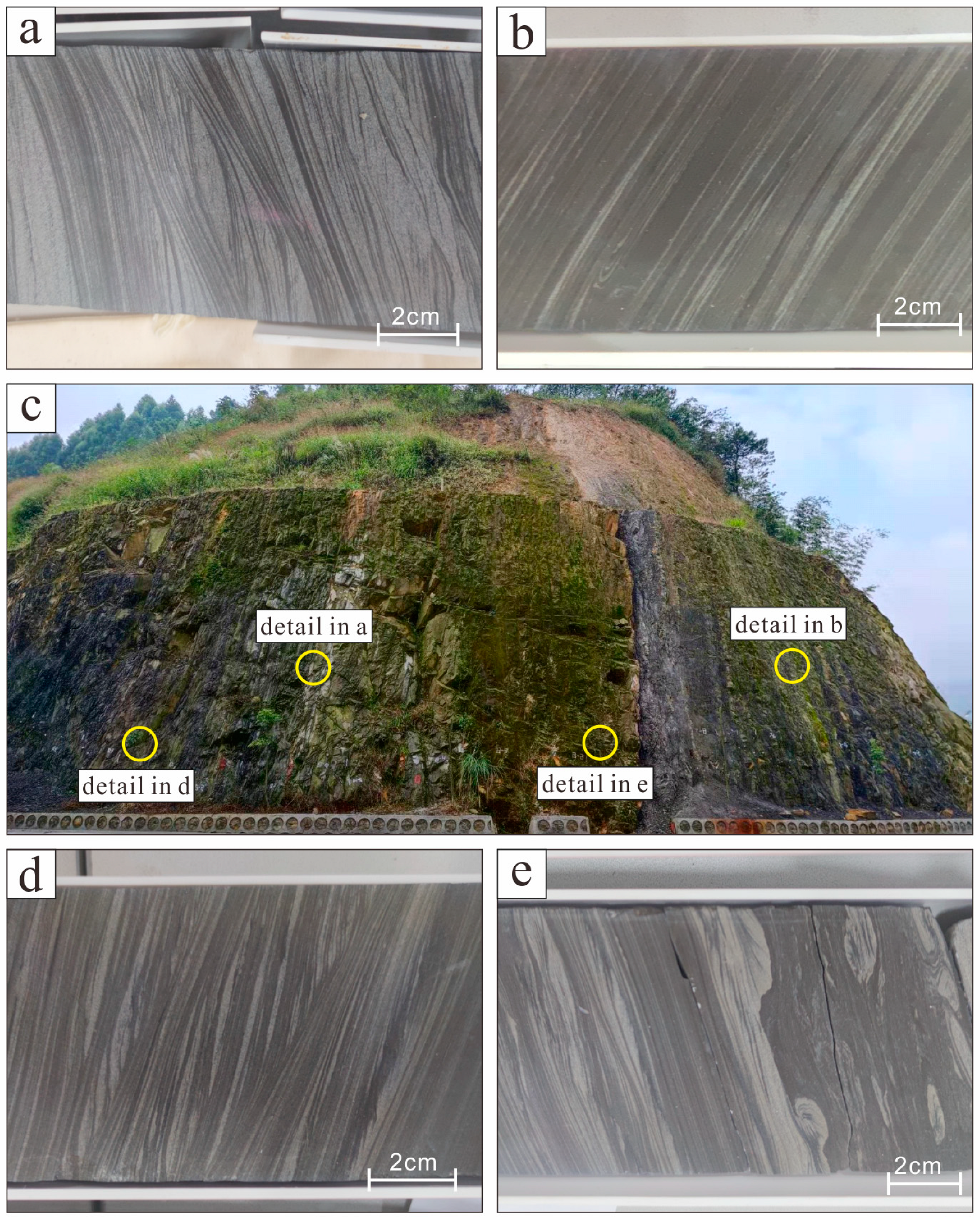
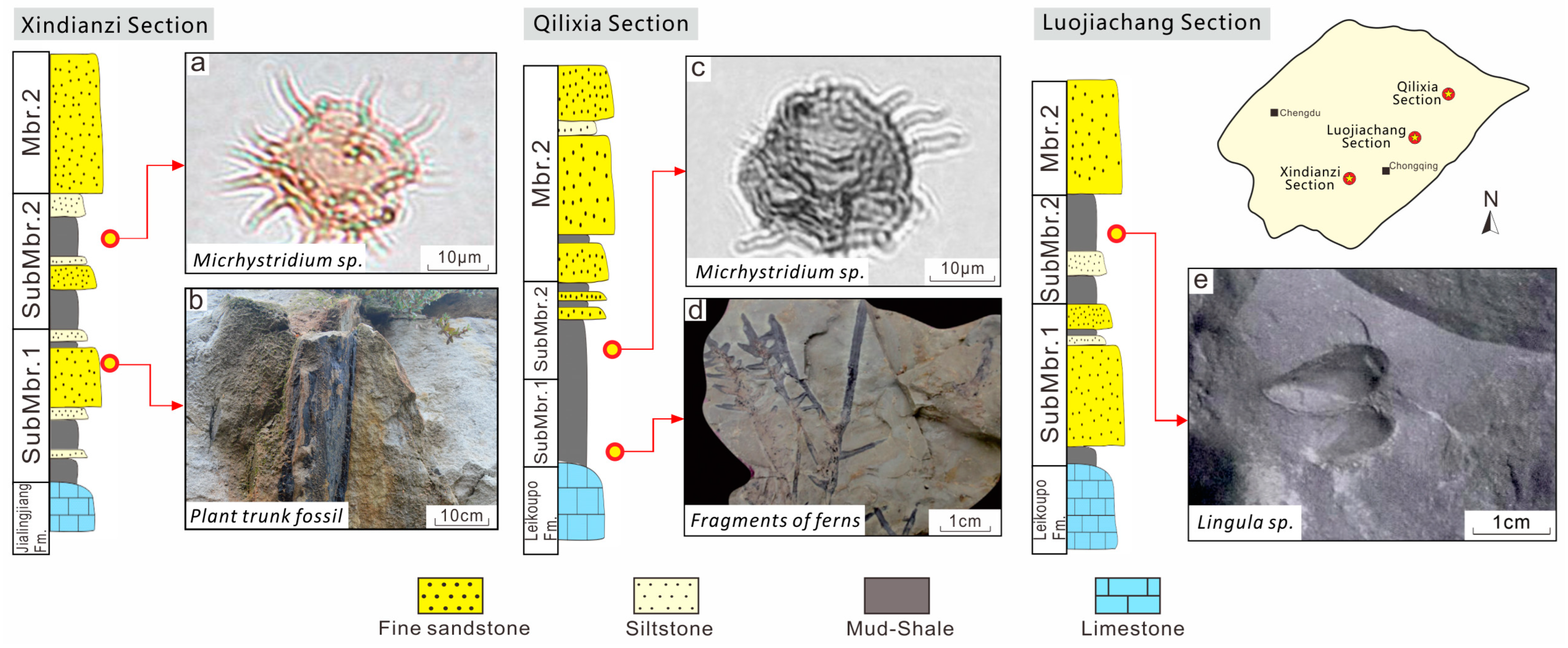
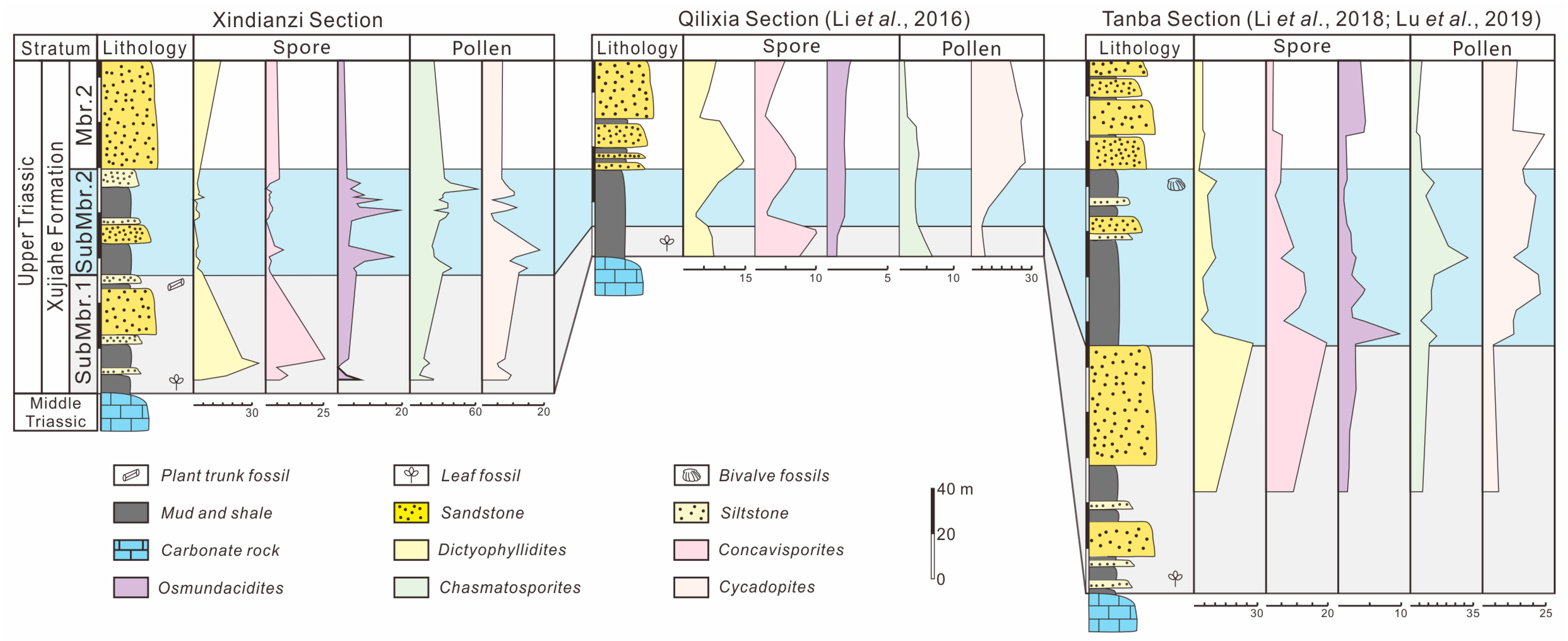


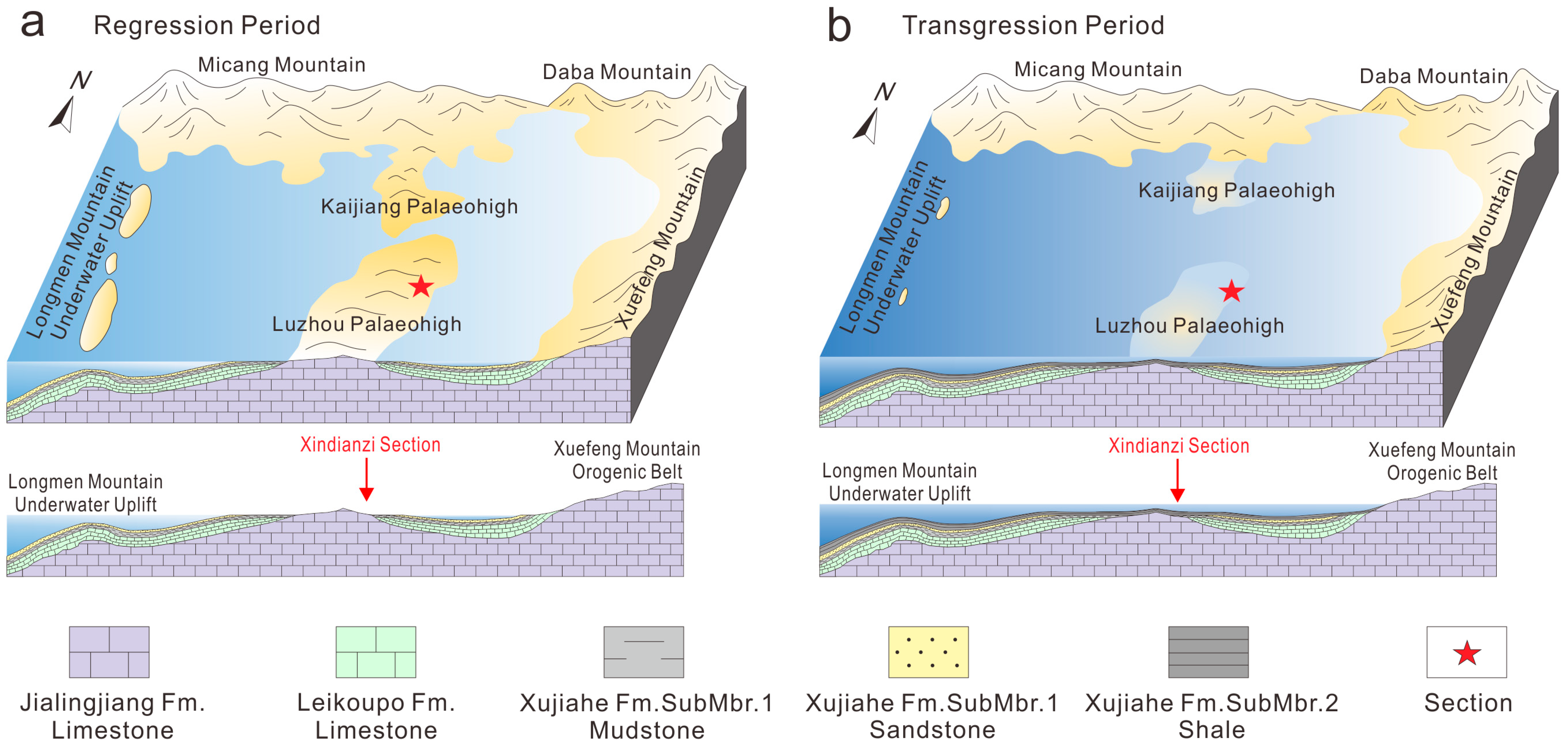
| Sample Number | Depth (m) | LOI (%) | SiO2 (%) | K2O (%) | Na2O (%) | CaO (%) | MgO (%) | Al2O3 (%) | TFe2O3 (%) | MnO (%) | TiO2 (%) | P2O5 (%) |
|---|---|---|---|---|---|---|---|---|---|---|---|---|
| 1 | 67.4 | 5.37 | 80.70 | 1.62 | 0.11 | 0.11 | 0.43 | 14.82 | 0.85 | 0.04 | 1.14 | 0.03 |
| 2 | 68.4 | 4.00 | 80.61 | 2.63 | 0.12 | 0.17 | 0.60 | 13.34 | 1.43 | 0.01 | 0.89 | 0.05 |
| 3 | 93.9 | 6.64 | 73.95 | 2.42 | 0.12 | 0.06 | 0.54 | 16.97 | 4.87 | 0.04 | 0.80 | 0.07 |
| 4 | 129.6 | 8.04 | 68.87 | 3.26 | 0.15 | 0.09 | 0.91 | 18.99 | 6.27 | 0.02 | 1.18 | 0.07 |
| 5 | 130.4 | 5.30 | 78.99 | 2.52 | 0.12 | 0.08 | 0.59 | 15.57 | 0.90 | 0.02 | 0.99 | 0.07 |
| 6 | 145.8 | 4.22 | 82.62 | 1.55 | 0.10 | 0.11 | 0.72 | 9.52 | 4.51 | 0.02 | 0.63 | 0.09 |
| 7 | 147.5 | 7.75 | 66.37 | 3.99 | 0.15 | 0.10 | 1.76 | 19.04 | 7.18 | 0.04 | 1.05 | 0.13 |
| 8 | 307.9 | 6.73 | 70.89 | 3.58 | 0.36 | 0.14 | 1.68 | 16.61 | 5.54 | 0.03 | 0.85 | 0.13 |
| 9 | 308.6 | 6.32 | 73.19 | 3.28 | 0.42 | 0.12 | 1.35 | 14.62 | 5.92 | 0.05 | 0.69 | 0.19 |
| 10 | 310.2 | 6.42 | 65.32 | 4.12 | 0.17 | 0.34 | 2.51 | 18.48 | 7.56 | 0.19 | 0.91 | 0.19 |
| 11 | 311.6 | 7.53 | 67.79 | 4.30 | 0.20 | 0.07 | 2.11 | 19.47 | 4.77 | 0.03 | 0.93 | 0.07 |
| 12 | 324.7 | 8.32 | 64.60 | 4.36 | 0.15 | 0.59 | 1.90 | 20.44 | 6.54 | 0.08 | 0.95 | 0.20 |
| 13 | 326.1 | 9.43 | 58.78 | 5.25 | 0.17 | 0.08 | 1.44 | 24.98 | 7.99 | 0.01 | 1.00 | 0.09 |
| 14 | 326.7 | 15.28 | 64.92 | 5.05 | 0.17 | 0.32 | 1.40 | 24.55 | 2.32 | 0.01 | 0.99 | 0.03 |
| 15 | 391.0 | 17.03 | 50.66 | 2.05 | 0.15 | 0.16 | 1.10 | 30.01 | 14.78 | 0.03 | 0.80 | 0.07 |
| 16 | 446.2 | 5.83 | 74.03 | 4.39 | 0.16 | 0.14 | 0.87 | 17.70 | 1.64 | 0.02 | 0.84 | 0.03 |
| 17 | 453.0 | 7.03 | 64.12 | 6.02 | 0.18 | 0.22 | 1.35 | 23.23 | 3.44 | 0.03 | 1.05 | 0.10 |
| 18 | 495.5 | 18.09 | 53.26 | 3.68 | 0.16 | 17.68 | 4.40 | 14.34 | 5.20 | 0.22 | 0.71 | 0.18 |
| 19 | 495.8 | 15.15 | 58.19 | 3.73 | 0.18 | 12.18 | 4.38 | 14.97 | 5.08 | 0.20 | 0.72 | 0.22 |
| 20 | 496.3 | 19.49 | 48.25 | 3.67 | 0.15 | 22.22 | 4.38 | 14.52 | 5.41 | 0.30 | 0.69 | 0.25 |
| 21 | 497.6 | 9.90 | 65.54 | 3.56 | 0.45 | 4.96 | 3.64 | 14.42 | 6.02 | 0.23 | 0.76 | 0.22 |
| 22 | 499.9 | 3.52 | 76.06 | 3.32 | 1.02 | 0.36 | 1.36 | 12.14 | 4.91 | 0.04 | 0.47 | 0.17 |
| 23 | 517.0 | 5.92 | 73.05 | 4.79 | 0.16 | 0.15 | 1.28 | 17.64 | 1.84 | 0.01 | 0.87 | 0.03 |
| 24 | 517.8 | 7.12 | 65.70 | 4.84 | 0.16 | 0.41 | 2.57 | 19.08 | 5.82 | 0.03 | 0.94 | 0.23 |
| 25 | 518.5 | 7.68 | 67.57 | 3.98 | 0.20 | 2.07 | 3.31 | 15.51 | 6.08 | 0.09 | 0.79 | 0.19 |
| 26 | 525.3 | 5.55 | 73.28 | 3.53 | 0.56 | 0.49 | 1.44 | 13.91 | 5.59 | 0.03 | 0.68 | 0.27 |
| 27 | 552.5 | 4.18 | 81.44 | 2.86 | 0.12 | 0.09 | 0.91 | 10.92 | 2.76 | 0.03 | 0.68 | 0.05 |
| 28 | 564.2 | 4.82 | 78.97 | 3.02 | 0.13 | 0.11 | 1.34 | 11.72 | 3.67 | 0.03 | 0.71 | 0.09 |
| 29 | 565.3 | 5.52 | 77.32 | 3.24 | 0.14 | 0.13 | 1.33 | 13.07 | 3.69 | 0.02 | 0.78 | 0.10 |
| 30 | 567.1 | 6.28 | 71.38 | 4.74 | 0.14 | 0.11 | 1.56 | 17.66 | 2.96 | 0.03 | 1.15 | 0.06 |
| Sample Number | Depth (m) | V (ppm) | Cr (ppm) | Sr (ppm) | Ba (ppm) | U (ppm) | Th (ppm) | Ni (ppm) | Co (ppm) | Cu (ppm) |
|---|---|---|---|---|---|---|---|---|---|---|
| 1 | 67.4 | 132.61 | 74.21 | 81.51 | 234.54 | 4.59 | 19.89 | 29.35 | 9.66 | 28.63 |
| 2 | 68.4 | 82.49 | 50.66 | 82.84 | 444.34 | 3.76 | 15.45 | 24.04 | 10.41 | 16.14 |
| 3 | 93.9 | 75.46 | 48.85 | 92.40 | 856.91 | 3.63 | 14.85 | 25.13 | 10.56 | 14.12 |
| 4 | 129.6 | 68.50 | 47.49 | 65.37 | 353.82 | 3.46 | 14.21 | 18.33 | 6.16 | 13.17 |
| 5 | 130.4 | 77.18 | 57.93 | 79.28 | 863.55 | 3.21 | 15.88 | 24.94 | 11.21 | 12.31 |
| 6 | 145.8 | 97.23 | 67.08 | 77.17 | 565.21 | 3.13 | 16.24 | 29.76 | 12.28 | 22.05 |
| 7 | 147.5 | 126.90 | 78.12 | 78.25 | 559.49 | 3.92 | 18.95 | 34.82 | 19.04 | 35.73 |
| 8 | 307.9 | 98.86 | 51.42 | 66.82 | 567.52 | 3.54 | 15.32 | 14.81 | 6.13 | 41.51 |
| 9 | 308.6 | 52.91 | 45.34 | 82.98 | 563.64 | 1.95 | 10.33 | 29.23 | 12.61 | 11.23 |
| 10 | 310.2 | 89.82 | 53.42 | 91.63 | 475.76 | 2.90 | 13.29 | 26.82 | 12.89 | 20.99 |
| 11 | 311.6 | 86.84 | 43.27 | 204.39 | 313.02 | 2.84 | 9.89 | 29.79 | 11.79 | 25.01 |
| 12 | 324.7 | 91.42 | 43.90 | 124.48 | 343.83 | 3.09 | 10.15 | 29.44 | 11.38 | 24.54 |
| 13 | 326.1 | 97.80 | 46.60 | 194.43 | 351.02 | 3.08 | 10.80 | 28.74 | 10.39 | 27.72 |
| 14 | 326.7 | 163.85 | 80.99 | 145.49 | 674.12 | 4.07 | 19.74 | 11.57 | 5.38 | 8.34 |
| 15 | 391 | 99.17 | 50.67 | 81.23 | 541.93 | 3.50 | 17.68 | 10.50 | 1.84 | 10.51 |
| 16 | 446.2 | 170.38 | 121.50 | 40.33 | 313.68 | 4.69 | 26.89 | 34.14 | 15.91 | 20.21 |
| 17 | 453 | 152.34 | 58.70 | 71.24 | 427.09 | 5.92 | 15.30 | 52.73 | 8.93 | 58.80 |
| 18 | 495.5 | 150.65 | 102.39 | 74.46 | 444.56 | 4.85 | 21.87 | 37.62 | 9.94 | 45.37 |
| 19 | 495.8 | 115.53 | 84.40 | 67.29 | 398.31 | 3.66 | 16.87 | 30.45 | 11.10 | 32.53 |
| 20 | 496.3 | 129.90 | 69.82 | 78.84 | 1051.15 | 4.03 | 14.91 | 27.74 | 10.83 | 23.61 |
| 21 | 497.6 | 124.70 | 87.09 | 64.98 | 500.94 | 3.36 | 16.30 | 33.22 | 12.39 | 33.42 |
| 22 | 499.9 | 86.94 | 58.82 | 62.50 | 534.79 | 2.61 | 12.21 | 31.81 | 11.11 | 20.14 |
| 23 | 517 | 93.00 | 90.97 | 51.76 | 515.53 | 3.36 | 14.93 | 42.05 | 12.38 | 21.75 |
| 24 | 517.8 | 128.72 | 112.03 | 64.92 | 380.92 | 3.73 | 16.80 | 46.45 | 26.45 | 32.97 |
| 25 | 518.5 | 57.55 | 51.85 | 24.47 | 181.25 | 2.17 | 10.45 | 31.99 | 5.96 | 13.71 |
| 26 | 525.3 | 85.89 | 57.30 | 72.25 | 288.56 | 3.27 | 14.73 | 19.63 | 1.76 | 7.70 |
| 27 | 552.5 | 132.53 | 112.63 | 81.48 | 388.36 | 4.27 | 18.55 | 21.94 | 6.60 | 27.68 |
| 28 | 564.2 | 104.93 | 70.61 | 51.09 | 306.19 | 2.74 | 13.43 | 17.30 | 17.06 | 8.83 |
| 29 | 565.3 | 89.22 | 48.19 | 61.78 | 272.90 | 3.16 | 13.23 | 9.82 | 2.01 | 7.05 |
| 30 | 567.1 | 100.77 | 52.81 | 42.93 | 290.25 | 3.12 | 16.41 | 11.30 | 14.77 | 6.95 |
| No. | Lithology | Sapropelite Group | Exinite Group | Vitrinite Group | Inertinite Group | TI | Type | ||||||
|---|---|---|---|---|---|---|---|---|---|---|---|---|---|
| Planktonic Alga | Sapropelic Amorphous | Resinite | Cork | Cutinite | Spore Powder | Mycosporite | Humus Amorphous | Vitrinite | Fusinite | ||||
| 1 | Gray–black shale | 0.48 | 0.24 | 0.11 | 0.19 | 0.61 | 29.25 | II2 | |||||
| 2 | Gray–black shale | 0.32 | 0.26 | 0.22 | 0.65 | 7.25 | II2 | ||||||
| 3 | Gray–black shale | 0.35 | 0.05 | 0.38 | 0.72 | 2.5 | II2 | ||||||
| 4 | Dark mudstone | 0.87 | 0.25 | 0.3 | 0.33 | 2.4 | 0.1 | –59 | III | ||||
| 5 | Dark mudstone | 0.34 | 0.46 | 0.4 | 1.63 | –45.25 | III | ||||||
| 6 | Dark mudstone | 0.32 | 0.51 | 0.72 | 2.17 | –69.25 | III | ||||||
Disclaimer/Publisher’s Note: The statements, opinions and data contained in all publications are solely those of the individual author(s) and contributor(s) and not of MDPI and/or the editor(s). MDPI and/or the editor(s) disclaim responsibility for any injury to people or property resulting from any ideas, methods, instructions or products referred to in the content. |
© 2025 by the authors. Licensee MDPI, Basel, Switzerland. This article is an open access article distributed under the terms and conditions of the Creative Commons Attribution (CC BY) license (https://creativecommons.org/licenses/by/4.0/).
Share and Cite
Huang, H.; Zhang, T.; Zhang, X.; Liu, Y.; Gao, L.; Zhang, J. The Sedimentary Record of Marine–Continental Transitional Shales in the Upper Triassic of Xujiahe Formation, Southeast Sichuan Basin, China. J. Mar. Sci. Eng. 2025, 13, 646. https://doi.org/10.3390/jmse13040646
Huang H, Zhang T, Zhang X, Liu Y, Gao L, Zhang J. The Sedimentary Record of Marine–Continental Transitional Shales in the Upper Triassic of Xujiahe Formation, Southeast Sichuan Basin, China. Journal of Marine Science and Engineering. 2025; 13(4):646. https://doi.org/10.3390/jmse13040646
Chicago/Turabian StyleHuang, Hao, Tingshan Zhang, Xi Zhang, Yulong Liu, Lubiao Gao, and Jingxuan Zhang. 2025. "The Sedimentary Record of Marine–Continental Transitional Shales in the Upper Triassic of Xujiahe Formation, Southeast Sichuan Basin, China" Journal of Marine Science and Engineering 13, no. 4: 646. https://doi.org/10.3390/jmse13040646
APA StyleHuang, H., Zhang, T., Zhang, X., Liu, Y., Gao, L., & Zhang, J. (2025). The Sedimentary Record of Marine–Continental Transitional Shales in the Upper Triassic of Xujiahe Formation, Southeast Sichuan Basin, China. Journal of Marine Science and Engineering, 13(4), 646. https://doi.org/10.3390/jmse13040646




